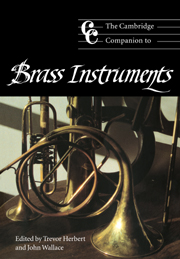Book contents
- Frontmatter
- Introduction
- 1 Lip-vibrated instruments of the ancient and non-western world
- 2 How brass instruments work
- 3 Design, technology and manufacture before 1800
- 4 Brass instruments in art music in the Middle Ages
- 5 The cornett
- 6 ‘Sackbut’: the early trombone
- 7 The trumpet before 1800
- 8 The horn in the Baroque and Classical periods
- 9 Design, technology and manufacture since 1800
- 10 Keyed brass
- 11 The low brass
- 12 Brass in the modern orchestra
- 13 Brass bands and other vernacular brass traditions
- 14 Playing, learning and teaching brass
- 15 The post-classical horn
- 16 Jazz, improvisation and brass
- 17 Brass solo and chamber music from 1800
- 18 Frontiers or byways? Brass instruments in avant-garde music
- Glossary
- Notes
- Select bibliography
- Index
14 - Playing, learning and teaching brass
Published online by Cambridge University Press: 28 September 2011
- Frontmatter
- Introduction
- 1 Lip-vibrated instruments of the ancient and non-western world
- 2 How brass instruments work
- 3 Design, technology and manufacture before 1800
- 4 Brass instruments in art music in the Middle Ages
- 5 The cornett
- 6 ‘Sackbut’: the early trombone
- 7 The trumpet before 1800
- 8 The horn in the Baroque and Classical periods
- 9 Design, technology and manufacture since 1800
- 10 Keyed brass
- 11 The low brass
- 12 Brass in the modern orchestra
- 13 Brass bands and other vernacular brass traditions
- 14 Playing, learning and teaching brass
- 15 The post-classical horn
- 16 Jazz, improvisation and brass
- 17 Brass solo and chamber music from 1800
- 18 Frontiers or byways? Brass instruments in avant-garde music
- Glossary
- Notes
- Select bibliography
- Index
Summary
The earliest methods of instruction on brass instruments were probably based on imitation; signals and simple ensemble pieces were probably learned by rote. The first documented brotherhood of musicians was the Nicolai-Zechbrüder which was chartered in 1288 in Vienna and functioned until 1782. Five trumpets formed a fraternity in Lucca, also in 1288. The Confrérie de Saint-Julien was founded in 1321 and lasted until 1773. By 1330, musicians' brotherhoods expanded, and thirty-one such organisations met in Tournai to discuss common issues. Not until the written records and apprenticeship indentures of the guilds and Stadtpfeifer become available is there tangible evidence of how instruction actually took place. Members of church or civic ensembles and court musicians are seldom seen in pictures with printed music in front of them. This suggests that the music they were playing was memorised. Keith Polk has described ‘the existence of a tightly interwoven network of contacts which would have connected players and repertory in Glogau, Leipzig, Nuremberg, Augsburg, Ferrara, and Florence, and, for that matter with Brussels, Mechelen and Antwerp’. How did they learn their craft? The possession of a highly developed memory and a talent for improvisation, in addition to the timeless prerequisite of a keen ear, were essential to success as a musician in the Middle Ages and early Renaissance.
Manuscript and printed instruction material survives from the Renaissance. The idiom that brass players followed can be deduced from the works of such writers as Ganassi, Ortiz, Maffei, Dalla Casa, Bassano, Conforti, Bovicelli and Virgiliano. A concise study of the manuals of these writers by Howard Mayor Brown, Embellishing Sixteenth-Century Musky is a good starting point for modern players of early brass instruments, as it provides an overview of sixteenth-century practices. In the seventeenth century, Rognoni continued the discussion of technique and used the model of the human voice as the ideal for wind players to imitate
- Type
- Chapter
- Information
- The Cambridge Companion to Brass Instruments , pp. 193 - 206Publisher: Cambridge University PressPrint publication year: 1997
- 1
- Cited by



